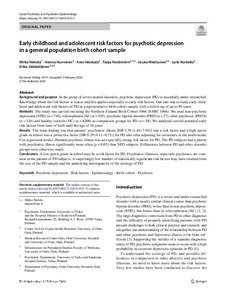Early childhood and adolescent risk factors for psychotic depression in a general population birth cohort sample
Huovinen H; Miettunen J; Heiskala A; Jääskeläinen E; Nietola M; Korkeila J; Nordström T
Early childhood and adolescent risk factors for psychotic depression in a general population birth cohort sample
Huovinen H
Miettunen J
Heiskala A
Jääskeläinen E
Nietola M
Korkeila J
Nordström T
SPRINGER HEIDELBERG
Julkaisun pysyvä osoite on:
https://urn.fi/URN:NBN:fi-fe2021042825698
https://urn.fi/URN:NBN:fi-fe2021042825698
Tiivistelmä
Background and purpose In the group of severe mental disorders, psychotic depression (PD) is essentially under-researched. Knowledge about the risk factors is scarce and this applies especially to early risk factors. Our aim was to study early childhood and adolescent risk factors of PD in a representative birth cohort sample with a follow-up of up to 50 years. Methods The study was carried out using the Northern Finland Birth Cohort 1966 (NFBC 1966). We used non-psychotic depression (NPD) (n = 746), schizophrenia (SZ) (n = 195), psychotic bipolar disorder (PBD) (n = 27), other psychoses (PNOS) (n = 136) and healthy controls (HC) (n = 8200) as comparison groups for PD (n = 58). We analysed several potential early risk factors from time of birth until the age of 16 years. Results The main finding was that parents' psychiatric illness [HR 3.59 (1.84-7.04)] was a risk factor and a high sports grade in school was a protective factor [HR 0.29 (0.11-0.73)] for PD also after adjusting for covariates in the multivariate Cox regression model. Parental psychotic illness was an especially strong risk factor for PD. The PD subjects had a parent with psychiatric illness significantly more often (p < 0.05) than NPD subjects. Differences between PD and other disorder groups were otherwise small. Conclusions A low sports grade in school may be a risk factor for PD. Psychiatric illnesses, especially psychoses, are common in the parents of PD subjects. A surprisingly low number of statistically significant risk factors may have resulted from the size of the PD sample and the underlying heterogeneity of the etiology of PD.
Kokoelmat
- Rinnakkaistallenteet [19207]
